Case Study: Ethical and Moral Issues of Fetal Abnormality
VerifiedAdded on 2023/06/05
|7
|1598
|368
Case Study
AI Summary
This case study examines the ethical and moral dilemmas arising from a diagnosis of fetal abnormality, specifically Down syndrome and the absence of hands. It focuses on the perspectives of the expectant parents, Marco and Jessica, Dr. Wilson, and Aunt Maria, highlighting their differing viewpoints on abortion, religious beliefs, socioeconomic concerns, and the moral status of the fetus. The study explores the application of various ethical theories, including personhood theory, moral agency, and relationship theory, to determine the moral standing of the fetus and guide decision-making. The conclusion emphasizes the importance of respecting individual autonomy and providing informed choices in such sensitive situations, advocating for the couple's right to make their own decisions. References to relevant ethical and medical literature are included.
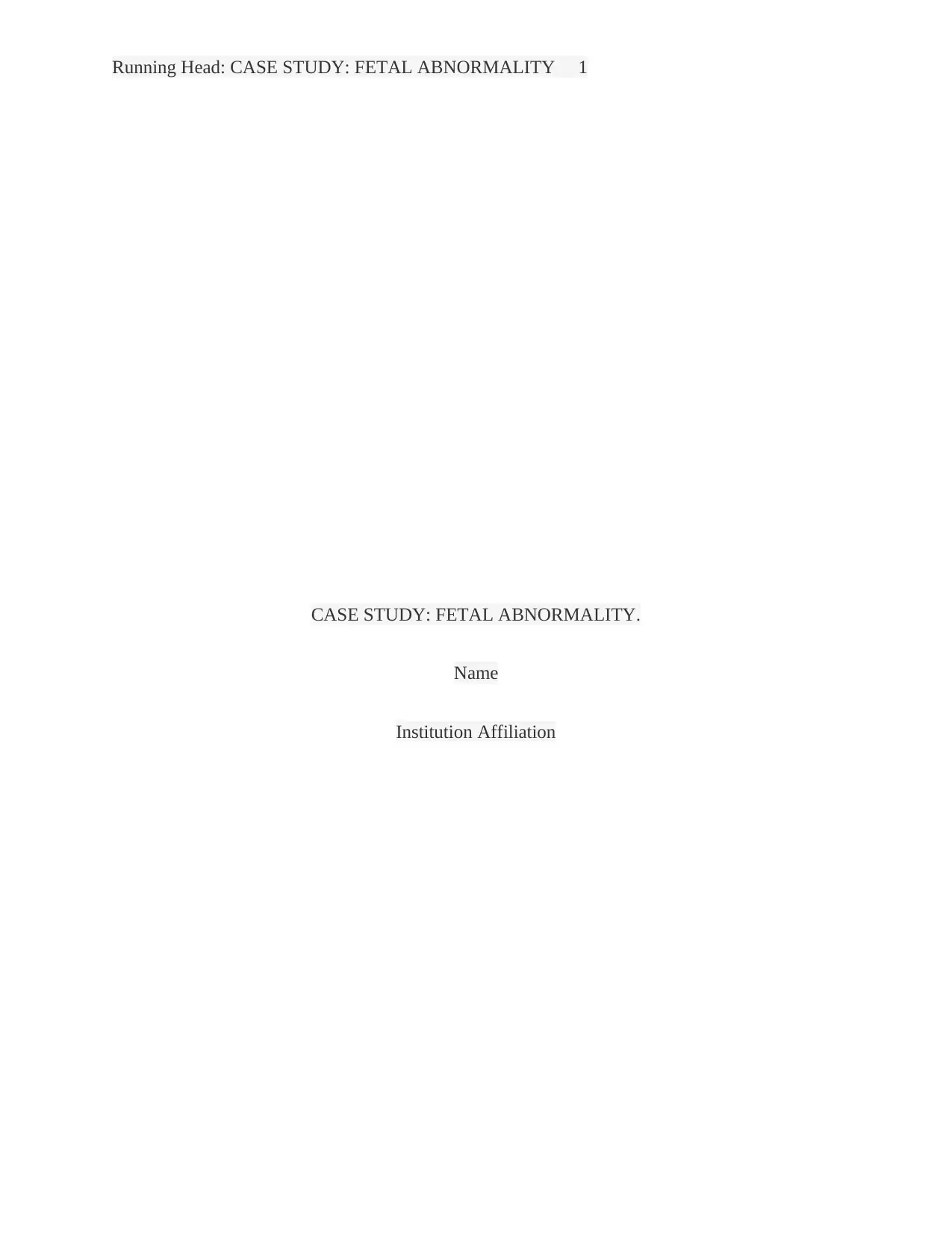
Running Head: CASE STUDY: FETAL ABNORMALITY 1
CASE STUDY: FETAL ABNORMALITY.
Name
Institution Affiliation
CASE STUDY: FETAL ABNORMALITY.
Name
Institution Affiliation
Paraphrase This Document
Need a fresh take? Get an instant paraphrase of this document with our AI Paraphraser
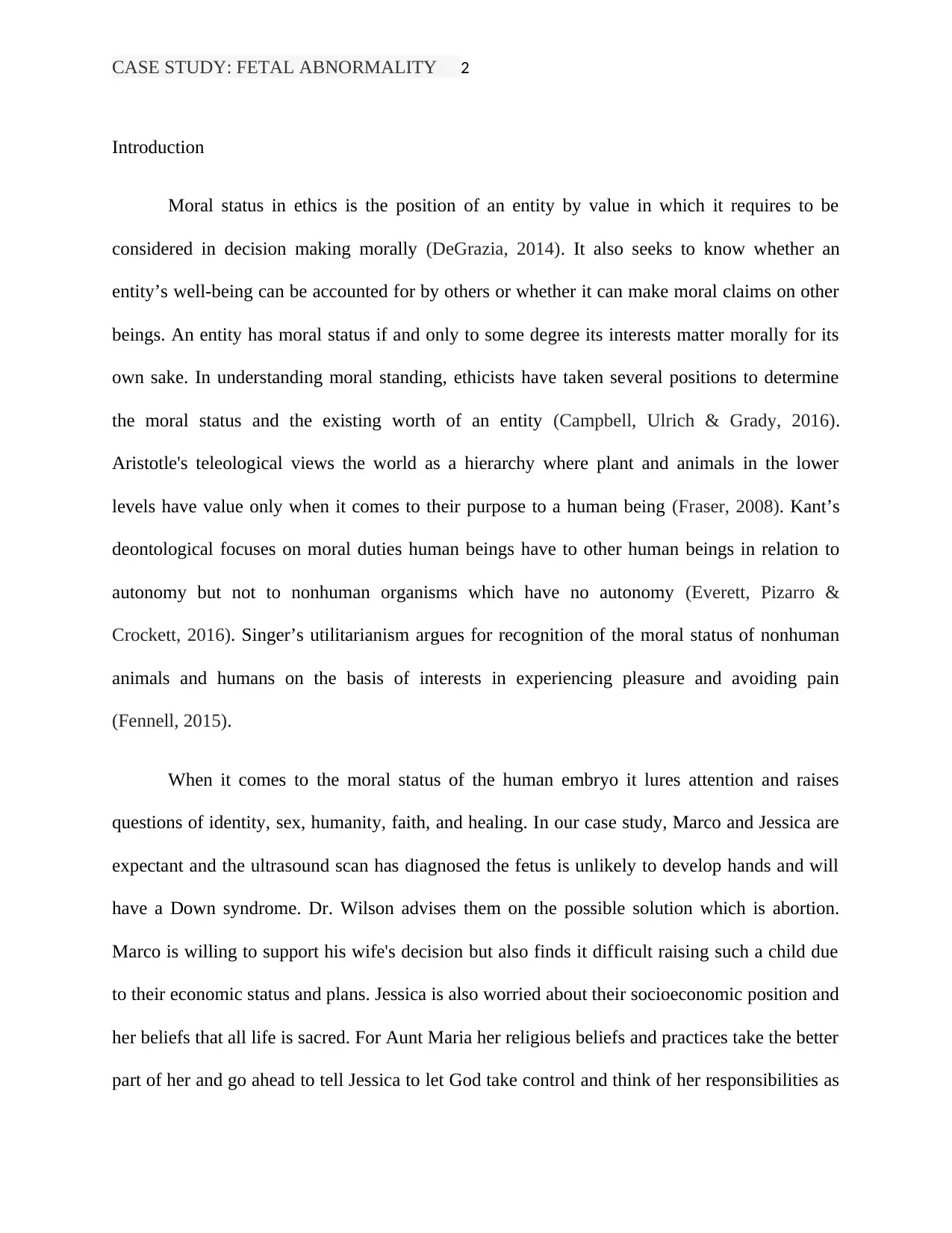
CASE STUDY: FETAL ABNORMALITY 2
Introduction
Moral status in ethics is the position of an entity by value in which it requires to be
considered in decision making morally (DeGrazia, 2014). It also seeks to know whether an
entity’s well-being can be accounted for by others or whether it can make moral claims on other
beings. An entity has moral status if and only to some degree its interests matter morally for its
own sake. In understanding moral standing, ethicists have taken several positions to determine
the moral status and the existing worth of an entity (Campbell, Ulrich & Grady, 2016).
Aristotle's teleological views the world as a hierarchy where plant and animals in the lower
levels have value only when it comes to their purpose to a human being (Fraser, 2008). Kant’s
deontological focuses on moral duties human beings have to other human beings in relation to
autonomy but not to nonhuman organisms which have no autonomy (Everett, Pizarro &
Crockett, 2016). Singer’s utilitarianism argues for recognition of the moral status of nonhuman
animals and humans on the basis of interests in experiencing pleasure and avoiding pain
(Fennell, 2015).
When it comes to the moral status of the human embryo it lures attention and raises
questions of identity, sex, humanity, faith, and healing. In our case study, Marco and Jessica are
expectant and the ultrasound scan has diagnosed the fetus is unlikely to develop hands and will
have a Down syndrome. Dr. Wilson advises them on the possible solution which is abortion.
Marco is willing to support his wife's decision but also finds it difficult raising such a child due
to their economic status and plans. Jessica is also worried about their socioeconomic position and
her beliefs that all life is sacred. For Aunt Maria her religious beliefs and practices take the better
part of her and go ahead to tell Jessica to let God take control and think of her responsibilities as
Introduction
Moral status in ethics is the position of an entity by value in which it requires to be
considered in decision making morally (DeGrazia, 2014). It also seeks to know whether an
entity’s well-being can be accounted for by others or whether it can make moral claims on other
beings. An entity has moral status if and only to some degree its interests matter morally for its
own sake. In understanding moral standing, ethicists have taken several positions to determine
the moral status and the existing worth of an entity (Campbell, Ulrich & Grady, 2016).
Aristotle's teleological views the world as a hierarchy where plant and animals in the lower
levels have value only when it comes to their purpose to a human being (Fraser, 2008). Kant’s
deontological focuses on moral duties human beings have to other human beings in relation to
autonomy but not to nonhuman organisms which have no autonomy (Everett, Pizarro &
Crockett, 2016). Singer’s utilitarianism argues for recognition of the moral status of nonhuman
animals and humans on the basis of interests in experiencing pleasure and avoiding pain
(Fennell, 2015).
When it comes to the moral status of the human embryo it lures attention and raises
questions of identity, sex, humanity, faith, and healing. In our case study, Marco and Jessica are
expectant and the ultrasound scan has diagnosed the fetus is unlikely to develop hands and will
have a Down syndrome. Dr. Wilson advises them on the possible solution which is abortion.
Marco is willing to support his wife's decision but also finds it difficult raising such a child due
to their economic status and plans. Jessica is also worried about their socioeconomic position and
her beliefs that all life is sacred. For Aunt Maria her religious beliefs and practices take the better
part of her and go ahead to tell Jessica to let God take control and think of her responsibilities as
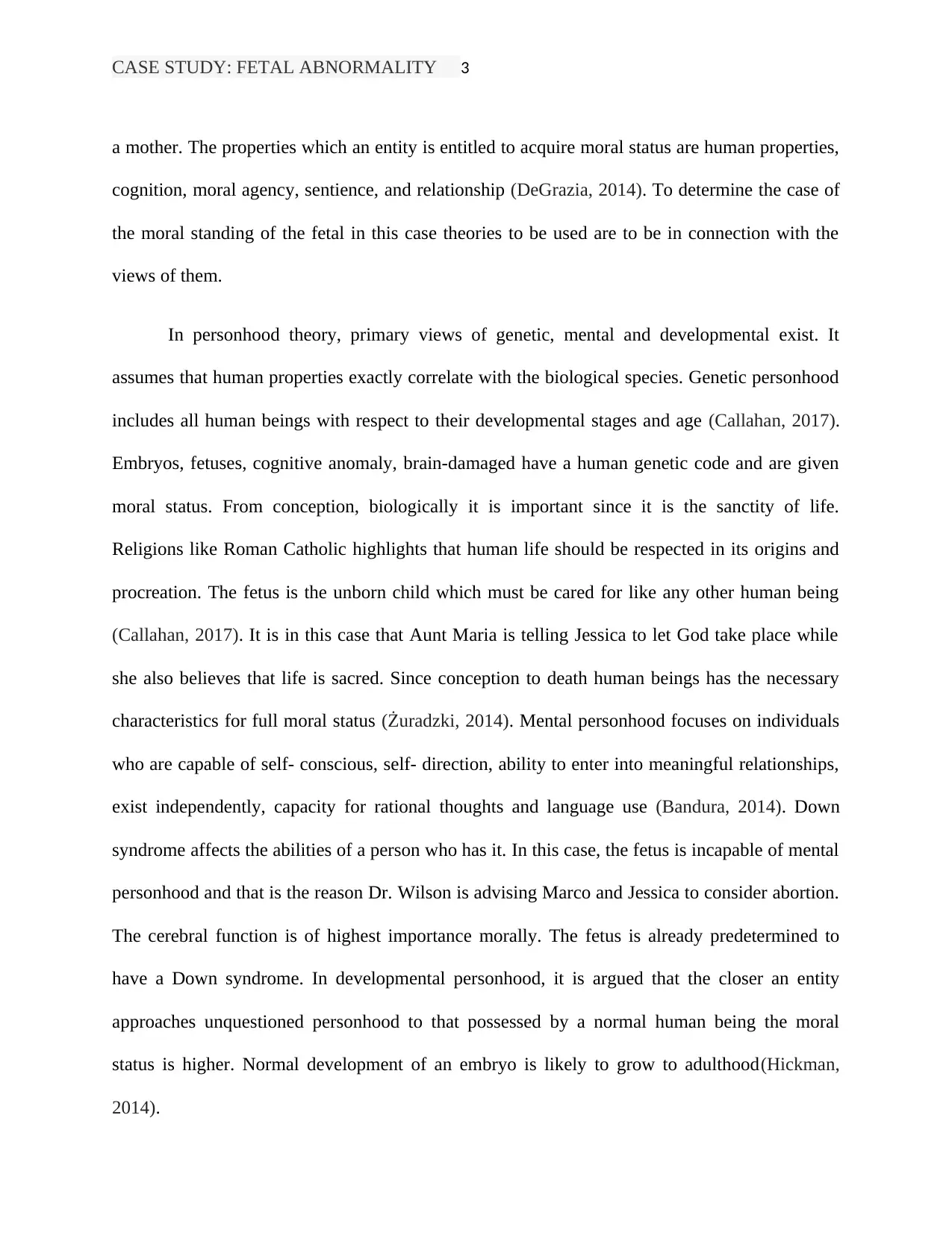
CASE STUDY: FETAL ABNORMALITY 3
a mother. The properties which an entity is entitled to acquire moral status are human properties,
cognition, moral agency, sentience, and relationship (DeGrazia, 2014). To determine the case of
the moral standing of the fetal in this case theories to be used are to be in connection with the
views of them.
In personhood theory, primary views of genetic, mental and developmental exist. It
assumes that human properties exactly correlate with the biological species. Genetic personhood
includes all human beings with respect to their developmental stages and age (Callahan, 2017).
Embryos, fetuses, cognitive anomaly, brain-damaged have a human genetic code and are given
moral status. From conception, biologically it is important since it is the sanctity of life.
Religions like Roman Catholic highlights that human life should be respected in its origins and
procreation. The fetus is the unborn child which must be cared for like any other human being
(Callahan, 2017). It is in this case that Aunt Maria is telling Jessica to let God take place while
she also believes that life is sacred. Since conception to death human beings has the necessary
characteristics for full moral status (Żuradzki, 2014). Mental personhood focuses on individuals
who are capable of self- conscious, self- direction, ability to enter into meaningful relationships,
exist independently, capacity for rational thoughts and language use (Bandura, 2014). Down
syndrome affects the abilities of a person who has it. In this case, the fetus is incapable of mental
personhood and that is the reason Dr. Wilson is advising Marco and Jessica to consider abortion.
The cerebral function is of highest importance morally. The fetus is already predetermined to
have a Down syndrome. In developmental personhood, it is argued that the closer an entity
approaches unquestioned personhood to that possessed by a normal human being the moral
status is higher. Normal development of an embryo is likely to grow to adulthood(Hickman,
2014).
a mother. The properties which an entity is entitled to acquire moral status are human properties,
cognition, moral agency, sentience, and relationship (DeGrazia, 2014). To determine the case of
the moral standing of the fetal in this case theories to be used are to be in connection with the
views of them.
In personhood theory, primary views of genetic, mental and developmental exist. It
assumes that human properties exactly correlate with the biological species. Genetic personhood
includes all human beings with respect to their developmental stages and age (Callahan, 2017).
Embryos, fetuses, cognitive anomaly, brain-damaged have a human genetic code and are given
moral status. From conception, biologically it is important since it is the sanctity of life.
Religions like Roman Catholic highlights that human life should be respected in its origins and
procreation. The fetus is the unborn child which must be cared for like any other human being
(Callahan, 2017). It is in this case that Aunt Maria is telling Jessica to let God take place while
she also believes that life is sacred. Since conception to death human beings has the necessary
characteristics for full moral status (Żuradzki, 2014). Mental personhood focuses on individuals
who are capable of self- conscious, self- direction, ability to enter into meaningful relationships,
exist independently, capacity for rational thoughts and language use (Bandura, 2014). Down
syndrome affects the abilities of a person who has it. In this case, the fetus is incapable of mental
personhood and that is the reason Dr. Wilson is advising Marco and Jessica to consider abortion.
The cerebral function is of highest importance morally. The fetus is already predetermined to
have a Down syndrome. In developmental personhood, it is argued that the closer an entity
approaches unquestioned personhood to that possessed by a normal human being the moral
status is higher. Normal development of an embryo is likely to grow to adulthood(Hickman,
2014).
⊘ This is a preview!⊘
Do you want full access?
Subscribe today to unlock all pages.

Trusted by 1+ million students worldwide
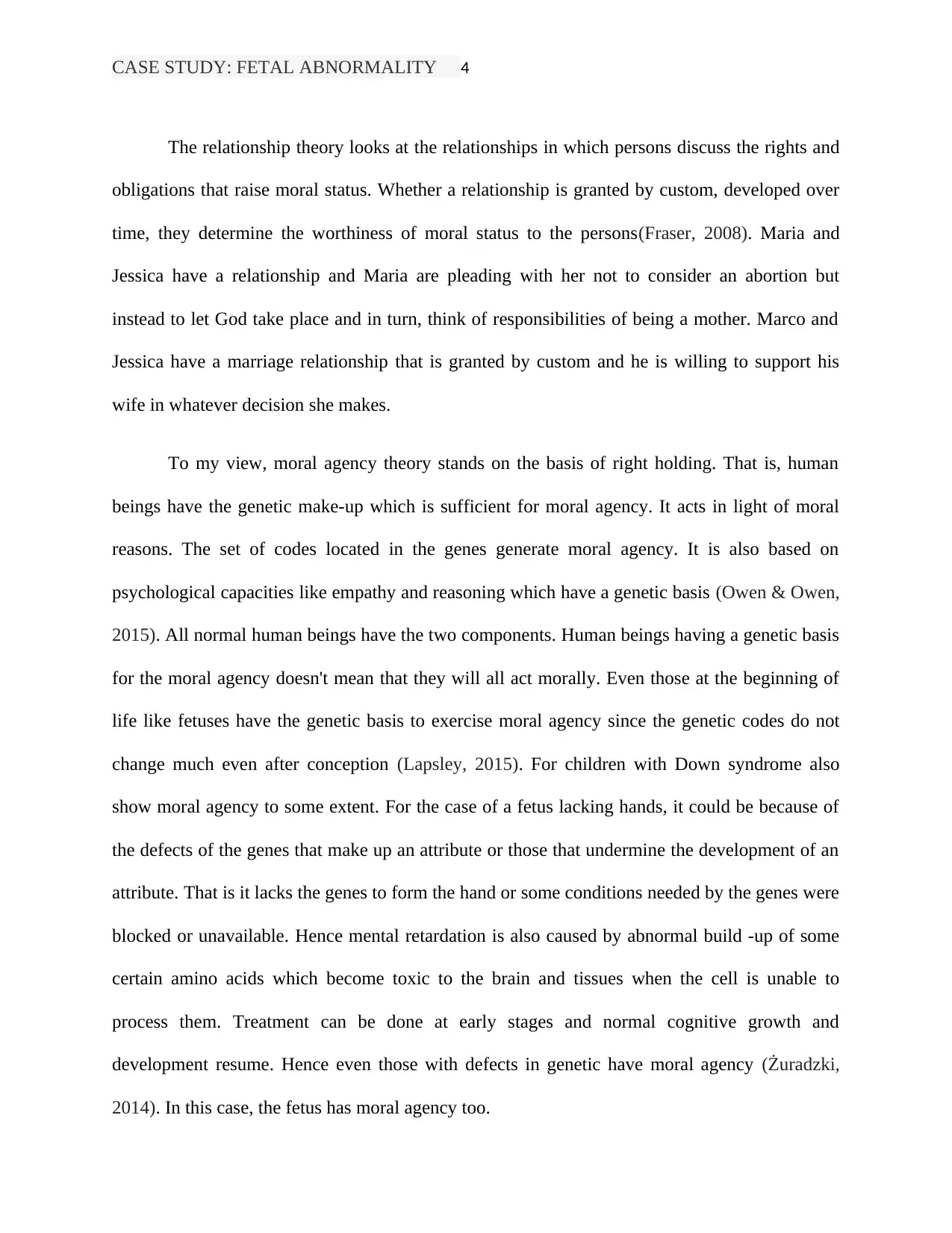
CASE STUDY: FETAL ABNORMALITY 4
The relationship theory looks at the relationships in which persons discuss the rights and
obligations that raise moral status. Whether a relationship is granted by custom, developed over
time, they determine the worthiness of moral status to the persons(Fraser, 2008). Maria and
Jessica have a relationship and Maria are pleading with her not to consider an abortion but
instead to let God take place and in turn, think of responsibilities of being a mother. Marco and
Jessica have a marriage relationship that is granted by custom and he is willing to support his
wife in whatever decision she makes.
To my view, moral agency theory stands on the basis of right holding. That is, human
beings have the genetic make-up which is sufficient for moral agency. It acts in light of moral
reasons. The set of codes located in the genes generate moral agency. It is also based on
psychological capacities like empathy and reasoning which have a genetic basis (Owen & Owen,
2015). All normal human beings have the two components. Human beings having a genetic basis
for the moral agency doesn't mean that they will all act morally. Even those at the beginning of
life like fetuses have the genetic basis to exercise moral agency since the genetic codes do not
change much even after conception (Lapsley, 2015). For children with Down syndrome also
show moral agency to some extent. For the case of a fetus lacking hands, it could be because of
the defects of the genes that make up an attribute or those that undermine the development of an
attribute. That is it lacks the genes to form the hand or some conditions needed by the genes were
blocked or unavailable. Hence mental retardation is also caused by abnormal build -up of some
certain amino acids which become toxic to the brain and tissues when the cell is unable to
process them. Treatment can be done at early stages and normal cognitive growth and
development resume. Hence even those with defects in genetic have moral agency (Żuradzki,
2014). In this case, the fetus has moral agency too.
The relationship theory looks at the relationships in which persons discuss the rights and
obligations that raise moral status. Whether a relationship is granted by custom, developed over
time, they determine the worthiness of moral status to the persons(Fraser, 2008). Maria and
Jessica have a relationship and Maria are pleading with her not to consider an abortion but
instead to let God take place and in turn, think of responsibilities of being a mother. Marco and
Jessica have a marriage relationship that is granted by custom and he is willing to support his
wife in whatever decision she makes.
To my view, moral agency theory stands on the basis of right holding. That is, human
beings have the genetic make-up which is sufficient for moral agency. It acts in light of moral
reasons. The set of codes located in the genes generate moral agency. It is also based on
psychological capacities like empathy and reasoning which have a genetic basis (Owen & Owen,
2015). All normal human beings have the two components. Human beings having a genetic basis
for the moral agency doesn't mean that they will all act morally. Even those at the beginning of
life like fetuses have the genetic basis to exercise moral agency since the genetic codes do not
change much even after conception (Lapsley, 2015). For children with Down syndrome also
show moral agency to some extent. For the case of a fetus lacking hands, it could be because of
the defects of the genes that make up an attribute or those that undermine the development of an
attribute. That is it lacks the genes to form the hand or some conditions needed by the genes were
blocked or unavailable. Hence mental retardation is also caused by abnormal build -up of some
certain amino acids which become toxic to the brain and tissues when the cell is unable to
process them. Treatment can be done at early stages and normal cognitive growth and
development resume. Hence even those with defects in genetic have moral agency (Żuradzki,
2014). In this case, the fetus has moral agency too.
Paraphrase This Document
Need a fresh take? Get an instant paraphrase of this document with our AI Paraphraser
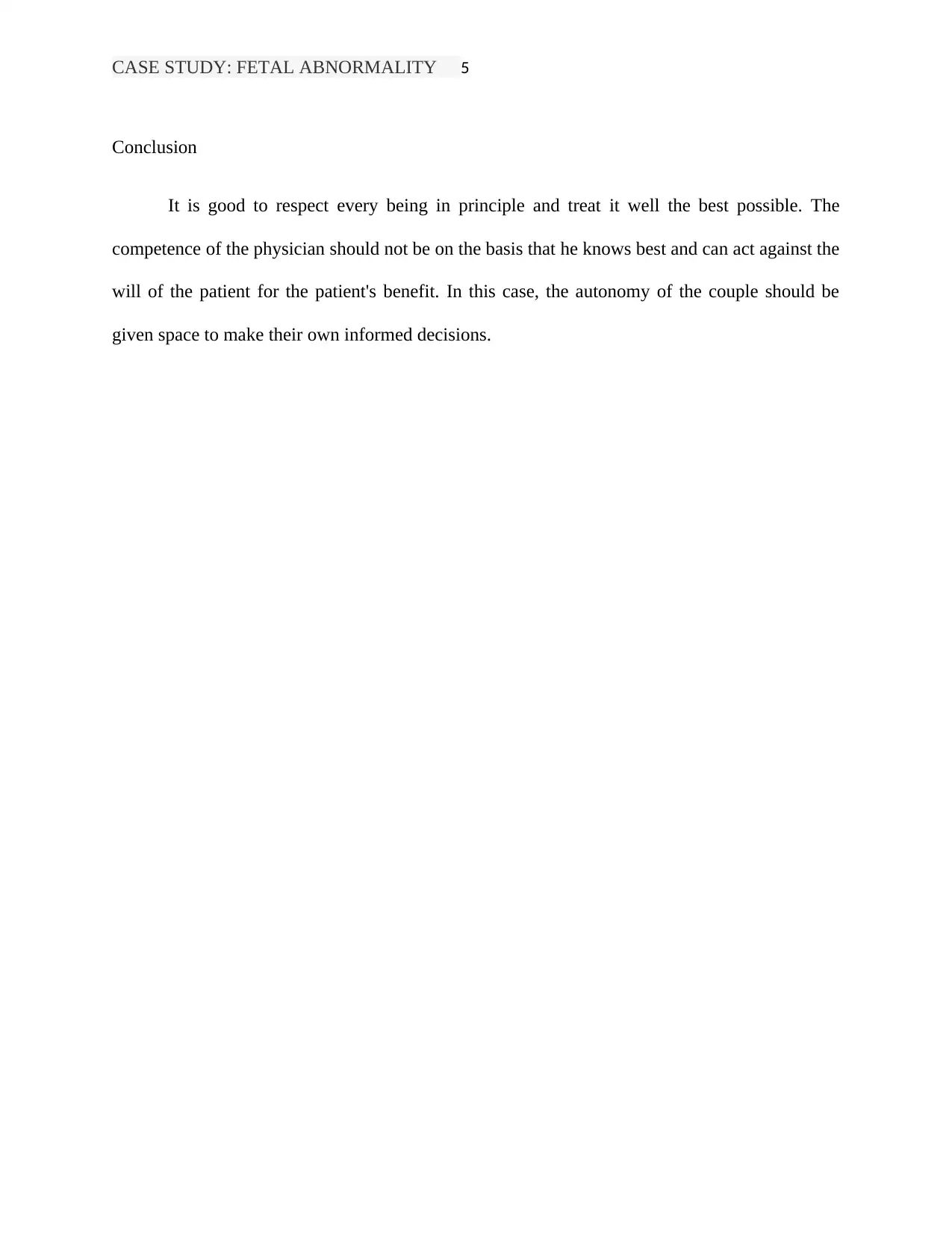
CASE STUDY: FETAL ABNORMALITY 5
Conclusion
It is good to respect every being in principle and treat it well the best possible. The
competence of the physician should not be on the basis that he knows best and can act against the
will of the patient for the patient's benefit. In this case, the autonomy of the couple should be
given space to make their own informed decisions.
Conclusion
It is good to respect every being in principle and treat it well the best possible. The
competence of the physician should not be on the basis that he knows best and can act against the
will of the patient for the patient's benefit. In this case, the autonomy of the couple should be
given space to make their own informed decisions.
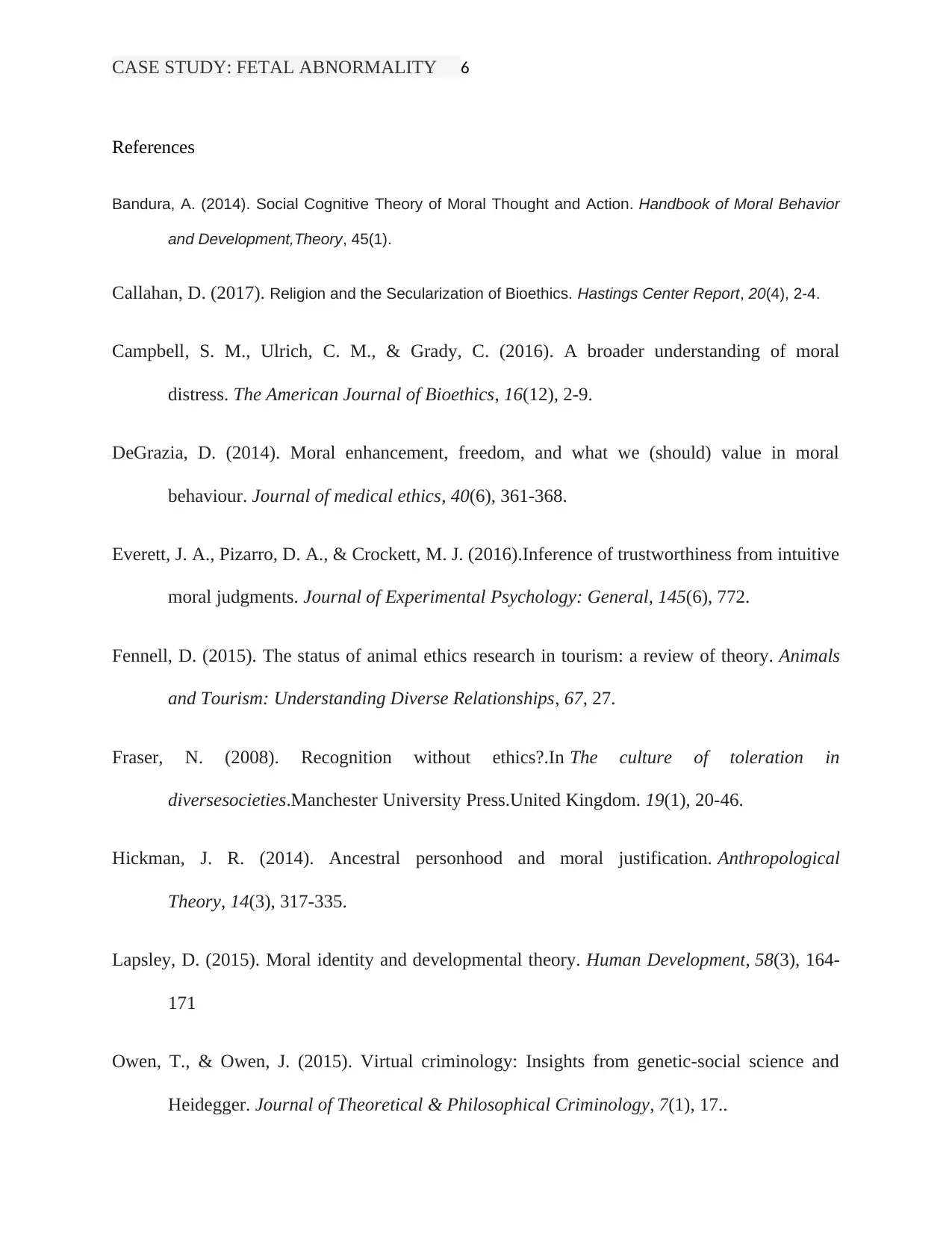
CASE STUDY: FETAL ABNORMALITY 6
References
Bandura, A. (2014). Social Cognitive Theory of Moral Thought and Action. Handbook of Moral Behavior
and Development,Theory, 45(1).
Callahan, D. (2017). Religion and the Secularization of Bioethics. Hastings Center Report, 20(4), 2-4.
Campbell, S. M., Ulrich, C. M., & Grady, C. (2016). A broader understanding of moral
distress. The American Journal of Bioethics, 16(12), 2-9.
DeGrazia, D. (2014). Moral enhancement, freedom, and what we (should) value in moral
behaviour. Journal of medical ethics, 40(6), 361-368.
Everett, J. A., Pizarro, D. A., & Crockett, M. J. (2016).Inference of trustworthiness from intuitive
moral judgments. Journal of Experimental Psychology: General, 145(6), 772.
Fennell, D. (2015). The status of animal ethics research in tourism: a review of theory. Animals
and Tourism: Understanding Diverse Relationships, 67, 27.
Fraser, N. (2008). Recognition without ethics?.In The culture of toleration in
diversesocieties.Manchester University Press.United Kingdom. 19(1), 20-46.
Hickman, J. R. (2014). Ancestral personhood and moral justification. Anthropological
Theory, 14(3), 317-335.
Lapsley, D. (2015). Moral identity and developmental theory. Human Development, 58(3), 164-
171
Owen, T., & Owen, J. (2015). Virtual criminology: Insights from genetic-social science and
Heidegger. Journal of Theoretical & Philosophical Criminology, 7(1), 17..
References
Bandura, A. (2014). Social Cognitive Theory of Moral Thought and Action. Handbook of Moral Behavior
and Development,Theory, 45(1).
Callahan, D. (2017). Religion and the Secularization of Bioethics. Hastings Center Report, 20(4), 2-4.
Campbell, S. M., Ulrich, C. M., & Grady, C. (2016). A broader understanding of moral
distress. The American Journal of Bioethics, 16(12), 2-9.
DeGrazia, D. (2014). Moral enhancement, freedom, and what we (should) value in moral
behaviour. Journal of medical ethics, 40(6), 361-368.
Everett, J. A., Pizarro, D. A., & Crockett, M. J. (2016).Inference of trustworthiness from intuitive
moral judgments. Journal of Experimental Psychology: General, 145(6), 772.
Fennell, D. (2015). The status of animal ethics research in tourism: a review of theory. Animals
and Tourism: Understanding Diverse Relationships, 67, 27.
Fraser, N. (2008). Recognition without ethics?.In The culture of toleration in
diversesocieties.Manchester University Press.United Kingdom. 19(1), 20-46.
Hickman, J. R. (2014). Ancestral personhood and moral justification. Anthropological
Theory, 14(3), 317-335.
Lapsley, D. (2015). Moral identity and developmental theory. Human Development, 58(3), 164-
171
Owen, T., & Owen, J. (2015). Virtual criminology: Insights from genetic-social science and
Heidegger. Journal of Theoretical & Philosophical Criminology, 7(1), 17..
⊘ This is a preview!⊘
Do you want full access?
Subscribe today to unlock all pages.

Trusted by 1+ million students worldwide
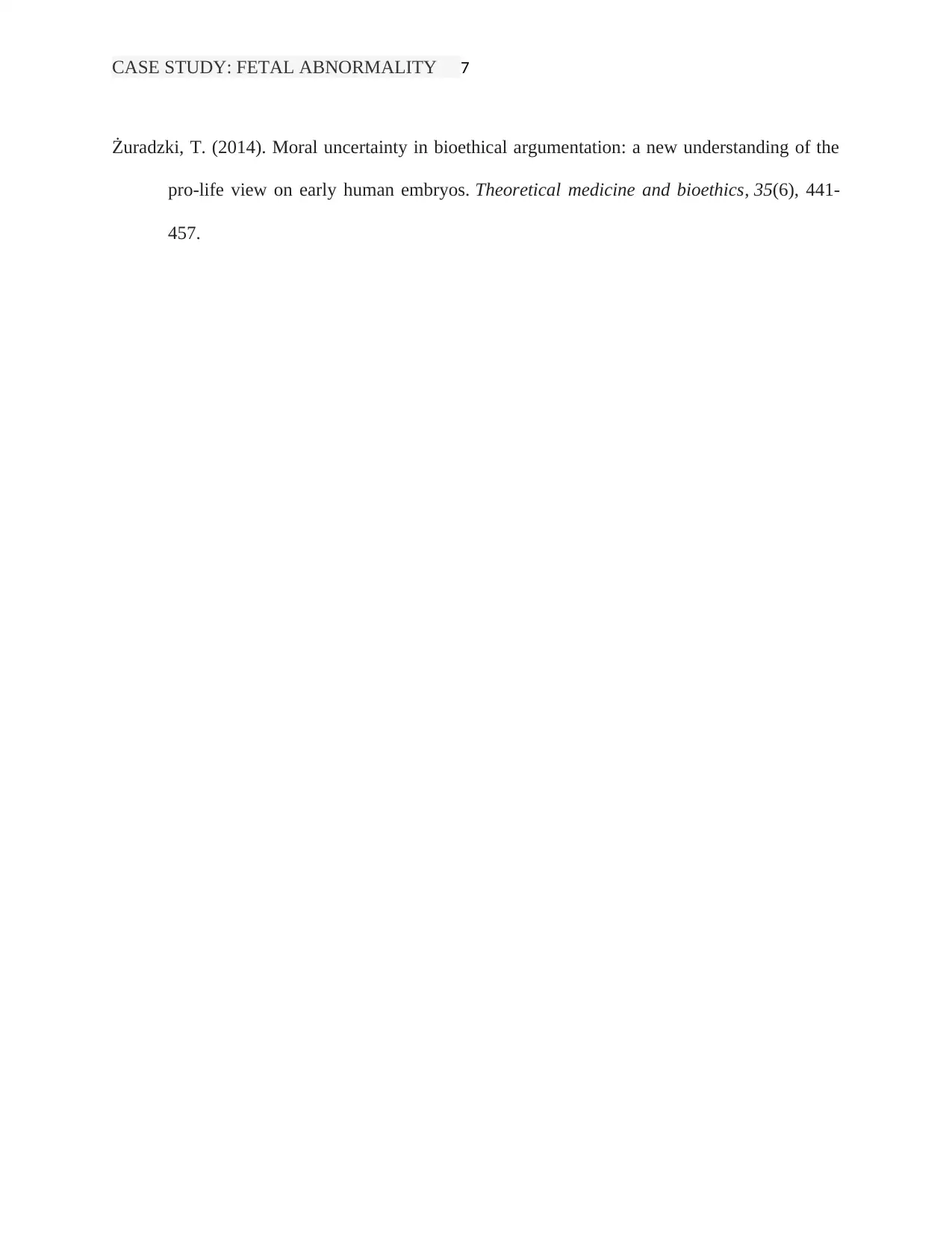
CASE STUDY: FETAL ABNORMALITY 7
Żuradzki, T. (2014). Moral uncertainty in bioethical argumentation: a new understanding of the
pro-life view on early human embryos. Theoretical medicine and bioethics, 35(6), 441-
457.
Żuradzki, T. (2014). Moral uncertainty in bioethical argumentation: a new understanding of the
pro-life view on early human embryos. Theoretical medicine and bioethics, 35(6), 441-
457.
1 out of 7
Related Documents
Your All-in-One AI-Powered Toolkit for Academic Success.
+13062052269
info@desklib.com
Available 24*7 on WhatsApp / Email
![[object Object]](/_next/static/media/star-bottom.7253800d.svg)
Unlock your academic potential
Copyright © 2020–2025 A2Z Services. All Rights Reserved. Developed and managed by ZUCOL.





